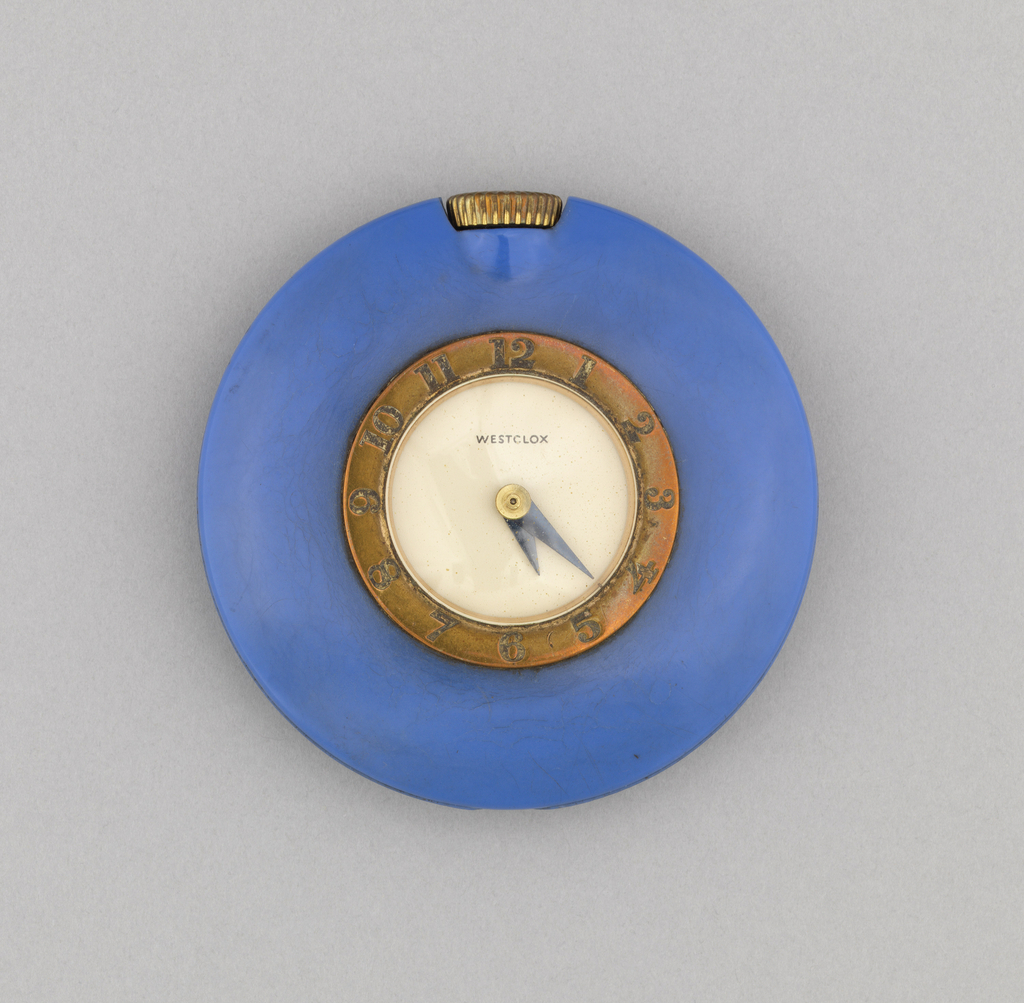This handbag watch, introduced in 1933 by the Westclox division of the General Time Instruments Corporation, offered the busy modern woman a portable, fashionable and discreet way to manage her time. [1] An alternative to wearing a wristwatch and about the size of a man’s pocket watch, this timepiece was large enough to be easily found among the articles in one’s purse, yet small enough to be comfortably held.
Simon De Vaulchier and George W. Blow, among the first generation of industrial designers, achieved the sophisticated modernist form by combining industrial materials. A simple circular, thermoplastic Bakelite housing resembling a rich lacquered surface (available in black, blue, red, or white) surrounds a metal band with bold Arabic numerals. The band encloses a plain white face that is embellished by only two elongated triangular dark metal hands and the manufacture’s name, beneath a slightly domed crystal. The housing is topped by an inset crown for winding the mechanism. The sleek form has no sharp edges or projections to puncture or catch on cosmetics containers sharing space in a purse, and the molded plastic and metal elements were tightly constructed to keep leaks or spills from penetrating the works.
Priced at $2.95, the handbag watch was considered affordable, and was sold in department stores, drug stores, and gift shops throughout the U.S. Westclox made it even more versatile by including a small collapsible easel, turning it into a timepiece for the nightstand or dressing table at home or in a hotel when traveling.
The handbag watch was a commercial and aesthetic success. “Presented as a novelty, it ran for five years, and sold twenty-three times the minimum necessary to cover expenses of tools and dies.”[2] The watch was included in the 1934 Museum of Modern Art exhibition, Machine Art, and a year later, won the Grand Prize at the Industrial Arts Exposition held at Rockefeller Center, achieving the distinction of “that product which…exhibits in the greatest degree the merits of beauty, utility, and availability.”[3]
[1] “An essential accessory, in these days of multiple engagements, is a watch. Many different types are shown at the jewelers to complete different types of costumes…[and] designed to be carried in a pocket or in a bag.” “Accessories After The Gown,” Harper’s Bazaar, June, 1932, p. 42.
[2] Harold Van Doren. Industrial Design: A Practical Guide (New York, NY: McGraw -Hill, 1940) pl. 25.
[3] “Watch Wins Art Prize: Kaufman Medal Awarded at the Industrial Design Arts Show.” New York Times, May 8, 1935, p. 17.
Cynthia Trope is the Associate Curator of Product Design and Decorative Arts at Cooper Hewitt, Smithsonian Design Museum.

One thought on ““An Essential Accessory””
William E. Meehan, Jr. on February 26, 2015 at 9:32 pm
Patents suggest George Waller Blow (1897-1960) was the designer of the Westclox Handbag Watch. Waller received patents for two related Westclox products, Design Patent 98,049 for Combined Paper Weight, Clock Calendar and Support Therefor filed 1935, issued 1936 (sold as Westclox Table Clock in Janney, Semple, Hill, & Company, Minneapolis, MN catalog, 1940) and Design Patent for 122,111 for Watch, 1940. Blow’s applied chapter ring reappeared in designs by Westclox in-house designer (later chief engineer) Max Schlenker’s (1903-1984) such as his Pittsfield Electric Alarm Clock, Design Patent 107,102, 1937 and his kitchen clock Design Patent 113,120 filed 1938, issued 1939.
“Be Up to the Minute With One of Our WATCH BAGS. They’re this season’s big enthusiasm! To have an attractive watch sat right in the side of a bag where you can tel the time at a glance is much more than a fashion whim – it’s the most constructive idea in bag design in years! WESTCLOX WATCH BAG (Calf) – $4.98.” The Brooklyn Daily Eagle, Thursday, November 14, 1935. “The watch is removable and comes with a small stand for the table.” The New York Sun, 1935. “Wesclox Watch Bags. Dependable Westclox watch *worth $2.95 alone.” Black or brown.” The Philadelphia Inquirer, Sunday, December 15, 1925.